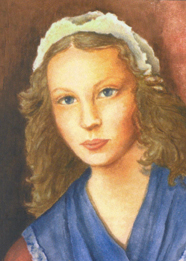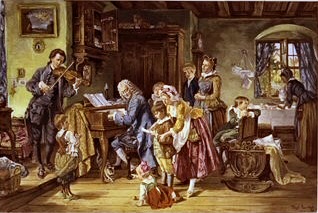Anna Magdalena Wilcke was born in Zeitz on 22 September 1701, the daughter of the court and field trumpeter Johann Caspar Wilcke. She spent her childhood and youth in Weißenfels in Thuringia.
Thanks to her musically ambitious parents, Anna Magdalena mastered the harpsichord and lute. She was trained as an excellent soprano, one of the first German professional singers ("Cantatricen"), by the court singer Pauline Kellner.
In 1721, after only three months of dating Johann Sebastian Bach, she became his second wife. As her wages as a court singer were considerable - she earned around half of her husband's salary - she continued to perform as a wife and stepmother. Anna Magdalena Bach filled her limited free time with copying her husband's works. Her musical handwriting is almost indistinguishable from his.
Johann Sebastian's "Clavir" and "Notenbüchlein", dedicated to Anna Magdalena in 1722 and 1725 as a gift of love, became famous. After the Bach family moved to Leipzig, Anna Magdalena gave birth to a total of 13 children between 1723 and 1742, seven of whom died. When Johann Sebastian Bach died in 1750, he left neither a written will nor any assets. On 27 February 1760, Anna Magdalena Bach died as an "almswoman" in Leipzig.

Anna Magdalena Bach
In the "Little Chronicle of Anna Magdalena Bach" *) Bach, the Sebastian she idolised, is described as follows.
Religion was something hidden in him that didn't always come out, but it was there and was never forgotten. There was something in him that filled me with fear at times, especially at the beginning of our marriage, a rock-solid rigour that served as a foundation and support for his kindness. But stranger than all of this was a fervent desire that accompanied him throughout his hard-working life, a desire for death. Only occasionally did I recognise it as if in a flash, for I think he often hid it from me because he felt it frightened me, for I was younger and not as courageous as he was. I felt no longing to leave him, nor the world, which seemed beautiful to me as long as he was in it. Now that I am old and alone and he has gone before me, I can better understand his longing to reach the place where all things are made perfect. Deep in his heart he carried the image of the Crucified One, and his noblest music is the death-wish cry that escapes him at the vision of the risen Saviour.

The Bach family making music
*) The English organist and writer Ester Meynell published "The Little Chronicle of Anna Magdalena Bach" in 1930.
From Anna Magdalenas Clavir- und Notenbüchlein